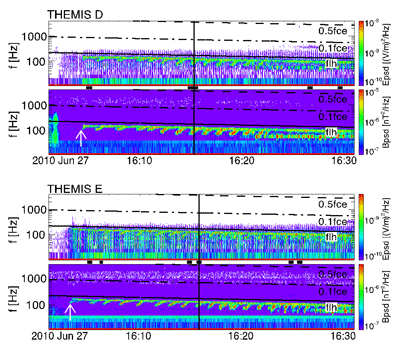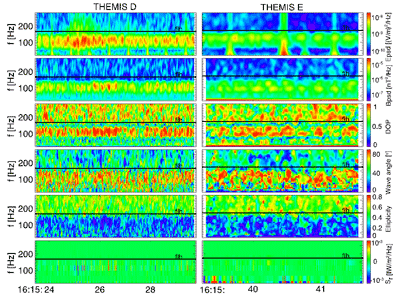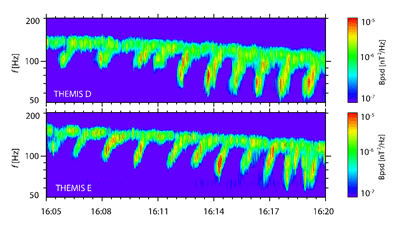
2014 THEMIS SCIENCE NUGGETS
First observation of rising-tone magnetosonic waves
by Huishan Fu
Space Science Institute, School of Astronautics, Beihang University, China
Introduction
Magnetosonic (MS) waves are linear-polarized emissions confined near the magnetic equator with wave normal angle near 90° and frequency below the lower hybrid frequency. Such waves are important because of their potential to accelerate radiation belt electrons to relativistic (MeV) energies, and therefore suggest a mechanism for transporting energy from the ring current to the Van Allen radiation belts. Studies over the past half-century believed that MS waves are “temporally continuous” in their time-frequency spectrogram, due to a quasi-linear generation process. Here we reveal for the first time that MS waves actually have discrete wave elements with rising-tone features in their spectrogram. The frequency sweep rate of MS waves, ~1 Hz/s, is between that of chorus and EMIC waves.
| Figure 1. Trajectories of THEMIS D (blue star) and E (red star) in the xy plane in solar magnetic (SM) coordinates, from 16:00 to 16:30 UT on 27 June 2010. The dotted blue line indicates the plasmapause location. |
| Figure 2. Measurements of VLF waves (10-4000 Hz) by THEMIS D (top two panels) and E (bottom two panels), during 1601–1630 UT on 27 June 2010. The first and third panels show the power spectral density of electric field (Epsd), while the second and fourth panels show the power spectral density of magnetic field (Bpsd). The black dots indicate the intervals, during which THEMIS were operated in the wave burst mode. |
Results
The event was measured by THEMIS D (THD) and E( THE) on 27 June 2010, from 1601 UT to 1630 UT. During that period, THD and THE traveled outbound in the inner magnetosphere, with an inter-spacecraft distance δr ≈ 2000 km (Figure 1). They both observed clear emissions at 60 Hz < f < 150 Hz, i.e., slightly below the lower hybrid resonance frequency (Figure 2). These emissions were found in both the electric and magnetic field components, so they are electromagnetic. The wave polarization analysis (Figure 3) at 16:15:24 – 16:15:30 UT (THD) and 16:15:39-16:15:42 UT (THE) shows that the degree of polarization (DOP) is close to 1; the wave normal angle (WNA) is larger than 80º; and the ellipticity is nearly zero. All these properties (including frequency range, linear polarization, large WNA and DOP) suggest that the emissions detected by THD and THE are MS waves. Figure 4 is a close-up view of the MS waves within frequency range 50 - 200 Hz during 1605-1620 UT. We find that MS waves consist of many discrete wave elements. Each wave element has duration of ~1 minute and a frequency sweep rate δf/δt ≈ 1.1 Hz/s. The time separation between two neighboring wave elements varies from 1 to 2 minutes, with on average ~1.5 minutes. We do not find the modulation of these wave elements by plasma density or by magnetic filed fluctuation. Such “rising-tone” MS waves are also observed by THEMIS on 27 August 2010, 10 August 2010, 11 August 2010, and 24 September 2010, meaning that they are very common emissions rather than unique.
| Figure 3. Polarization analysis of the 50–250 Hz waves at the time instants marked in Figure 2 (see the vertical lines there). Specifically shown from top to bottom are: Epsd, Bpsd, degree of polarization (DOP), wave normal angle, ellipticity, and the Poynting flux along the radial direction (Sr). THEMIS D and E measurements are presented in the left and right panels, respectively. |
Conclusion
The main conclusions can be briefly summarized as:
1. We discovered rising-tone MS waves outside the plasmapause
2. Frequency sweep rate: EMIC waves < MS waves < Chorus
3. Generation process of MS waves is quite possibly nonlinear
| Figure 4. A close-up view of Bpsd in the frequency range 50-200 Hz, during 1605–1620 UT on 27 June 2010. THEMIS D and E measurements are shown, respectively, in the top and bottom panels. |
Reference
In the video below, you can listen to a sonification of the magnetosonic waves while following along on the data plot. Since the bass frequencies of these waves are at 80-120Hz near the lower limit of human hearing, the rising tone is subtle yet audible. Audio data produced by Huishan Fu with further processing by E. Masongsong.
Fu, H. S., J. B. Cao, Z. Zhima, Y. V. Khotyaintsev, V. Angelopoulos, O. Santolík, Y. Omura, U. Taubenschuss, L. Chen, and S. Y. Huang (2014), First observation of rising-tone magnetosonic waves, Geophys. Res. Lett., 41, doi:10.1002/2014GL061867.
Biographical Note
Huishan Fu is a team leader at Space Science Institute, School of Astronautics, Beihang University, China. His research interests include wave-particle interaction, magnetic reconnection, and dipolarization fronts (see https://sites.google.com/site/huishanfu/home for more information).
 Please send comments/suggestions to
Emmanuel Masongsong / emasongsong @ igpp.ucla.edu
Please send comments/suggestions to
Emmanuel Masongsong / emasongsong @ igpp.ucla.edu




